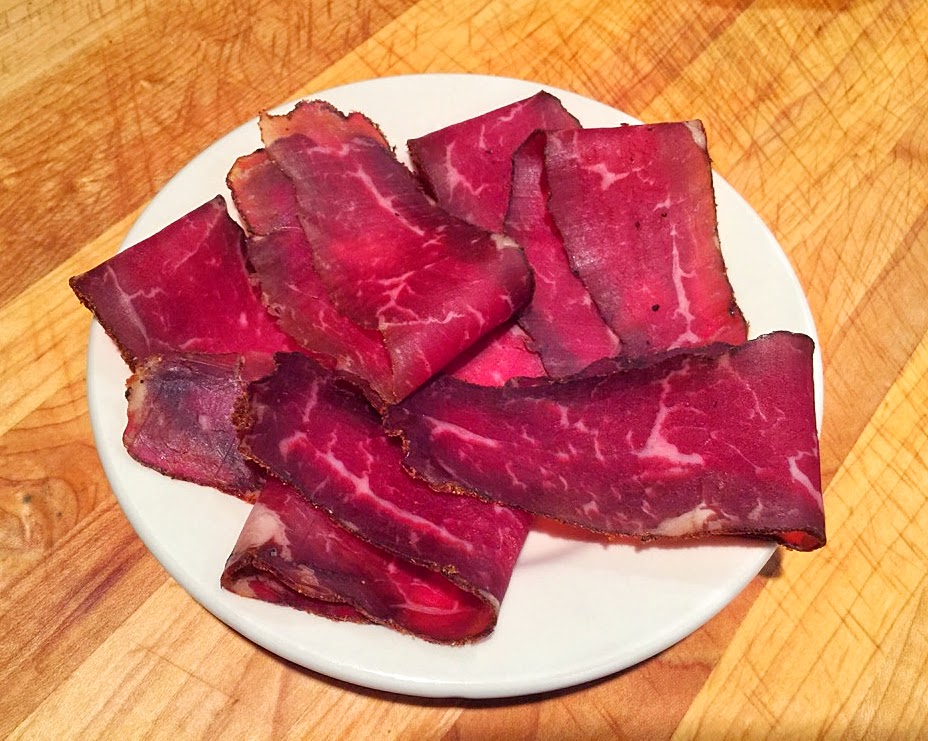Ottoman's Basturma

Here is an interesting tidbit (at least I think so) about the region (What was known as the Ottoman Empire). The area had many different versions of Basturma, and although some of the names were different, the recipes and techniques were very similar. Even the Jewish people call it pastirma or pastrómeh in Yiddish. Not to be confused or compared with Pastrami. Yea, yea, I know what you are thinking, so stop it. This is not an old version of Pastrami.
As I said the Basturma or Bastirma is infamous far and wide in the region with names such as pastërma in Albania, Basterma in Arabia, Basturma in Armenia, basdırma in Azerbaijan, pastirma in Bosnia, Croatia, Macedonia, and Serbia, pastărma in Bulgaria, pastourmás or pastroumás in Greece, and pastramă in Romania. Everyone has their own version and claims origins and superiority. I have come across some lively debates in forums that argue the about this cured piece of meat.
What exactly is Basturma? Traditional Basturma is made by salting meat, which is then washed with water and dried for about 10-15 days. Salt and blood are pressed out of the meat, and it is covered with “Cemen, also called Chaiman”, a cumin paste made by combining crushed cumin, garlic, hot paprika, and fenugreek. The meat is thoroughly air-dried. The variety of paprika being used determines the spiciness of the dish. It’s worth noting that in the Ottoman Empire, the craftsmen from Central Anatolia specialized in the art of preparing and curing Basturma. BTW- Anatolia is in Turkey, where they still claim to be the ones that came up with this cured meat.
I found this meat so intriguing that I ordered it online from several places so I might get acquainted with this highly seasoned cured meat. If I was going to make my own version of Basturma, I might as well taste it from different places, which of course, claim theirs is the best and the original. I think it’s obvious that any attempt at making this cured meat without first trying it would have been foolish. How can I possibly make something that I haven’t tried? This is likened to someone making Jewish food from a recipe. They have no idea what it tastes like or looks like, but they think they can make Jewish food. From my experience, this usually ends in failure or just a very poor attempt. Not me!! I Tasted my share of Basturma, and I think I can make it with modern curing techniques.
So let’s begin with the post. So I decided to use a Loin of Beef for my Basturma because it’s tasty and tender. Most of the recipes I have seen use this cut of beef, but I have seen the eye of round and Filet too. The whole thing weighed in at 6618 grams, and after trimming, it weighed 3871 grams. Yea, that sound like a lot of waste but not to fear, I am going to use the trim of sausage.
 |
| Instructions and Dry cure notes |


 |
| PIC 2- JUST CAME OUT OF UMAI BAG |
On April 8, it weighed in at 2495, just a hair above 35%. I should have weighed it sooner, but time got away from me. 35% should be perfect, though.
 |
| PIC 3-VACUUM SEALED |
The Basturma is now vacuumed and sealed in a regular bag and will sit there for about 8-10 weeks to equalize. I wanted the moisture levels to equalize under pressure. Well, that is/was my hope.
 |
| PIC 4- OUT OF VACUUM BAG |
Out of the vacuum bag, and it looks great. The outside has a shellac finish and feels good to the touch. Contrast picture 2 with 4, and you will see a huge difference. In pic 2, the outside crust is somewhat soft, but in pic 4, the outside took on a mahogany shellac finish. Well worth vacuum sealing and waiting 3 weeks.
REVIEW- Final pictures are below. Perfect!!! It took a year to figure out, and it was worth it. The only thing I would change is to add just a little bit more garlic..... maybe a .25%-.50% increase.




















Comments
Post a Comment